Genus Camponotus subgenus Myrmacrhaphe
| The Ants of
Africa Genus Camponotus subgenus Myrmacrhaphe |
|
| Genus Camponotus |
Subgenus definition - Section 13 Myrmacrhaphe Santschi (1926c: 607), type species conradti.
![]() Majors are described for only
two species (Santschi,
1926c) - conradti
and furvus
- head somewhat less narrow anteriorly; clypeus as with Myrmotrema
(with rectangular anterior lobe and with or without a carina) but
without fossae; scape short and not only just passing the occiput;
alitrunk in profile a more or less regular curve but not interrupted at
the level of the metanotal suture. The form I called Camponotus
(Myrmacrhaphe) species T² appears to be distinct from these.
The key below now includes the undescribed major of gabonensis.
Majors are described for only
two species (Santschi,
1926c) - conradti
and furvus
- head somewhat less narrow anteriorly; clypeus as with Myrmotrema
(with rectangular anterior lobe and with or without a carina) but
without fossae; scape short and not only just passing the occiput;
alitrunk in profile a more or less regular curve but not interrupted at
the level of the metanotal suture. The form I called Camponotus
(Myrmacrhaphe) species T² appears to be distinct from these.
The key below now includes the undescribed major of gabonensis.
Minors, known for all the species - generally black, most reticulated with variable pilosity; HL > HW; more or less narrowed anteriorly, with sides straight and medium eyes set in the posterior third; clypeus convex and slightly carinate, as wide as the anterior of the head in front and narrowing closely behind; scape surpassing the occiput; maxillary palps very long, the last segment as long as the apical segment of the antenna; pronotum strongly flattened and more or less bordered; propodeum very narrow; promesonotal suture very distinct but metanotal suture effaced on the sides; a group of 10 singular species, with a compressed and humped thorax, according to Bernard (1952). Bolton (1995) lists eight - all found in West Africa/Congo Basin.
Key to major workers
| 1 | Minor with narrow head and near parallel sides, occiput straight with angular corners | 2 |
| -- | Minor head distinctly narrower anteriorly, occiput at least weakly convex and corners rounded | 3 |
| 2 | 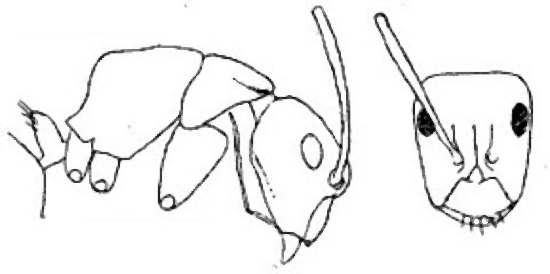 Minor worker TL 6.5
mm;
head as conradti but a little
less narrow; whole insect, except appendages with dense blanket of long
grey pubescence; but few erect hairs other than on declivity of
propodeum and petiole scale; generally submatt, reticulo-punctate less
finely on gaster, sides of gaster quite shiny; black with antennal
condyles, apex of funiculus and of tarsi ferruginous-brown Minor worker TL 6.5
mm;
head as conradti but a little
less narrow; whole insect, except appendages with dense blanket of long
grey pubescence; but few erect hairs other than on declivity of
propodeum and petiole scale; generally submatt, reticulo-punctate less
finely on gaster, sides of gaster quite shiny; black with antennal
condyles, apex of funiculus and of tarsi ferruginous-brown |
. |
| . | 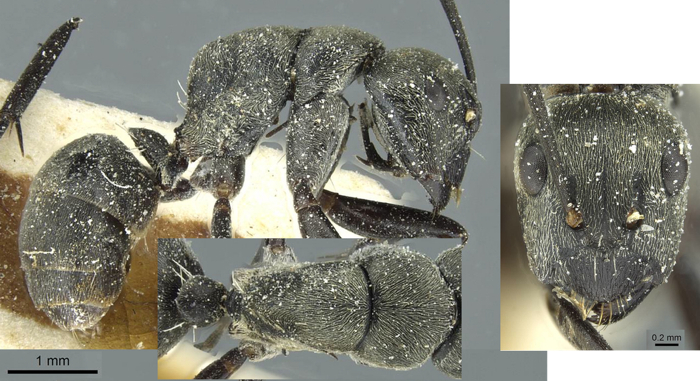 |
Zaïre - burgeoni |
| -- | 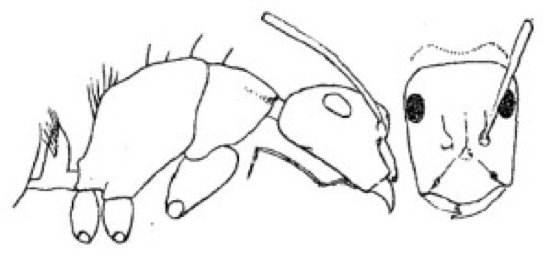 Worker
TL 6.5-7.0 mm; HL 1.25 X HW, head trapezoidal,
sides straight and convergent; quite abundant erect white pilosity
(yellow on clypeus); pubescence yellowish white and fine; generally
submatt, reticulo-punctate less finely on gaster, sides of gaster quite
shiny, appendages shiny; black, antennal condyles, apex of funiculus
and narrow posterior border of gaster segments yellow (fimbriatipes
descr) Worker
TL 6.5-7.0 mm; HL 1.25 X HW, head trapezoidal,
sides straight and convergent; quite abundant erect white pilosity
(yellow on clypeus); pubescence yellowish white and fine; generally
submatt, reticulo-punctate less finely on gaster, sides of gaster quite
shiny, appendages shiny; black, antennal condyles, apex of funiculus
and narrow posterior border of gaster segments yellow (fimbriatipes
descr) |
. |
| . |  |
. |
| . | 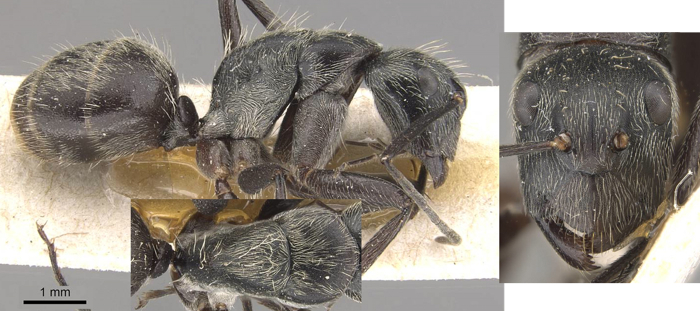 |
West Africa - conradti |
| . | 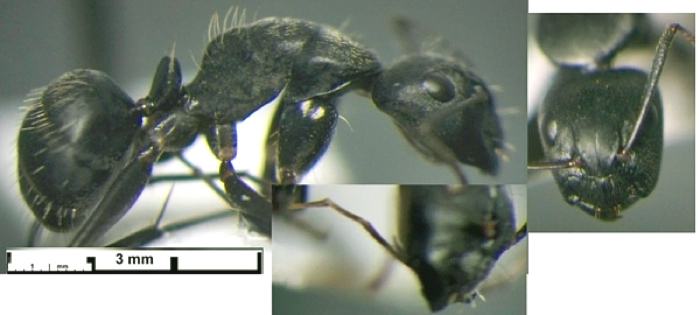 |
West Africa - conradti |
| 3 | Minor head with eyes large and breaking outline of head | 4 |
| -- | Minor head with smaller eyes not breaking outline of head | 6 |
| 4 | 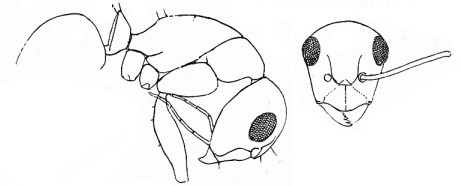 Minor
TL 4.2 mm; head anteriorly about 3/4 width of occiput; petiole profile
with sharp apex; black, apex of mandibles reddish; head and alitrunk
matt, head very finely sculpted, thorax finely reticulate; gaster
dorsum smooth and shiny; sparse erect hairs on body, short on the
internal borders of the femora; pubescence very short and very sparse. Minor
TL 4.2 mm; head anteriorly about 3/4 width of occiput; petiole profile
with sharp apex; black, apex of mandibles reddish; head and alitrunk
matt, head very finely sculpted, thorax finely reticulate; gaster
dorsum smooth and shiny; sparse erect hairs on body, short on the
internal borders of the femora; pubescence very short and very sparse. |
. |
| . |  |
Congo Basin - oculatior |
| -- | Minor head anteriorly almost as wide as occiput; petiole node rounded in profile | 5 |
| 5 | 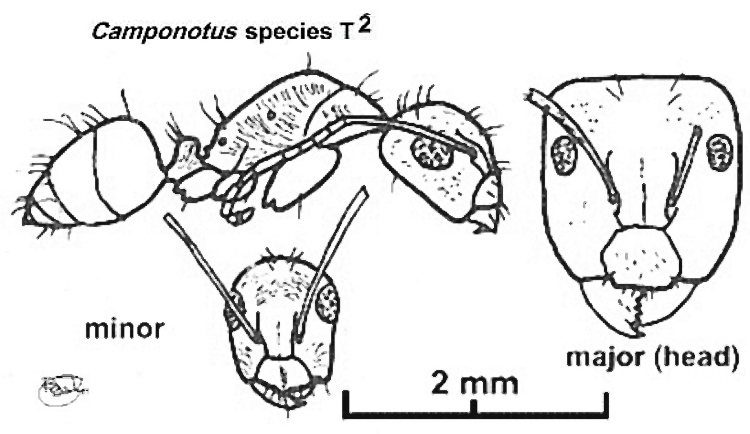 TL worker 4.39 mm;
major TL 6.97 mm; sculpturation of fine
striations most marked on alitrunk; pubescence very sparse; black,
extremities red-brown TL worker 4.39 mm;
major TL 6.97 mm; sculpturation of fine
striations most marked on alitrunk; pubescence very sparse; black,
extremities red-brown |
. |
| . |  |
Nigeria & Benin - Camponotus (Myrmacrhaphe) species T² |
| -- |  TL
worker 5.0 mm; long oblique white translucent hairs on head and thorax,
more numerous on declivity of propodeum, petiole scale and gaster; few
on the legs; pubescence whitish, short closely spaced on body and
appendages; very finely shagreened, dull; posterior angles of head and
pronotum, petiole scale and gaster with reduced sculpturation and
shinier; black; mandibles, antennae, inferior femora and articulation
of tibiae, yellow; rest of legs medium brown; borders of gaster
segments yellow TL
worker 5.0 mm; long oblique white translucent hairs on head and thorax,
more numerous on declivity of propodeum, petiole scale and gaster; few
on the legs; pubescence whitish, short closely spaced on body and
appendages; very finely shagreened, dull; posterior angles of head and
pronotum, petiole scale and gaster with reduced sculpturation and
shinier; black; mandibles, antennae, inferior femora and articulation
of tibiae, yellow; rest of legs medium brown; borders of gaster
segments yellow |
. |
| . |  |
Zaïre - rotundinodis |
| -- |  TL
worker 5.7 mm (major unknown); head with no more than fine erect hairs;
overall appearance shinier with much finer sculpturation TL
worker 5.7 mm (major unknown); head with no more than fine erect hairs;
overall appearance shinier with much finer sculpturation |
Cameroun & southern Sudan forest - tameri |
| . | Minor head with smaller eyes not breaking outline of head | . |
| 6 | Minor head relatively short and with rounded sides | 7 |
| -- | Minor head longer and with straight sides angled in to anterior margin | 8 |
| 7 | 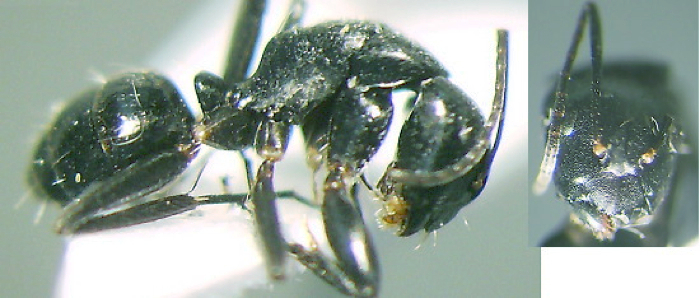 Worker TL 5.5-6.0 mm;
head narrowed anteriorly but less
than gabonensis; clypeus with more pronounced carina; alitrunk
profile as burgeoni; almost no erect hairs; greyish pubescence
generally sparse except on clypeus, occipitum; lower sides of alitrunk
matt or submatt but with generally more shiny areas than others; apex
of mandibles, antennal condyles and tarsi ferruginous Worker TL 5.5-6.0 mm;
head narrowed anteriorly but less
than gabonensis; clypeus with more pronounced carina; alitrunk
profile as burgeoni; almost no erect hairs; greyish pubescence
generally sparse except on clypeus, occipitum; lower sides of alitrunk
matt or submatt but with generally more shiny areas than others; apex
of mandibles, antennal condyles and tarsi ferruginous |
Congo Basin - florius |
| -- | 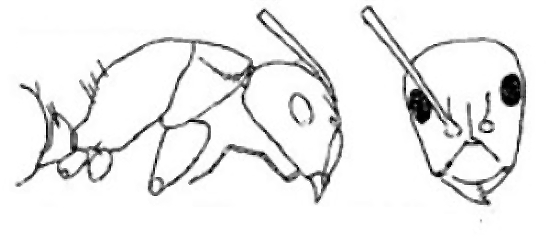 TL 6.5 mm; entirely
black with no lighter parts TL 6.5 mm; entirely
black with no lighter parts |
. |
| . |  Major Major |
. |
| . |  Minor Minor |
Congo & Ghana (?) - furvus |
| 8 |  Worker TL 7 mm;
petiole scale narrower; more matt than conradti;
black, terminal border of mandibles, antennal condyles, distal joints
of femora and trochanters ferruginous; Worker TL 7 mm;
petiole scale narrower; more matt than conradti;
black, terminal border of mandibles, antennal condyles, distal joints
of femora and trochanters ferruginous; |
. |
| . |  Type Type |
Congo & Gabon - gabonensis |
| . | 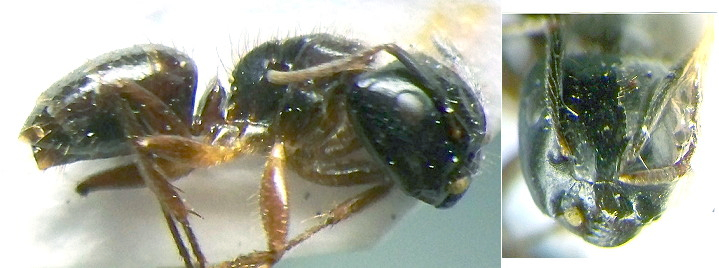 |
. |
| . |  |
Congo & Gabon - gabonensis |
| -- |  Worker TL 6.4 mm;
antennal condyles, much of body shiny,
dorsum of head and alitrunk reticulo-punctate and matt; black, apex of
funiculus and labrum rust Worker TL 6.4 mm;
antennal condyles, much of body shiny,
dorsum of head and alitrunk reticulo-punctate and matt; black, apex of
funiculus and labrum rust |
. |
| . |  |
. |
| . | 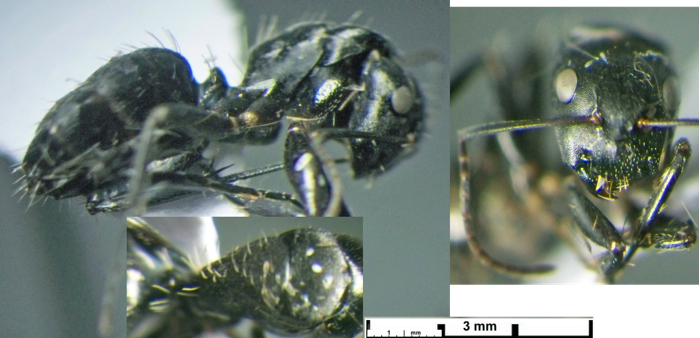 |
CAR & Zaïre - longipalpis |
Described by Bernard (1952) as typical of the subgenus (thorax, humped and compressed) but clearly different from four forms (of 10 known) which he sighted in the Swiss collection. As the original descriptions were poor, he felt unable to describe this form as a new species. Lamotte had collected 4 adult workers, with olive-green reflections, and two immatures, from a tall termite hill at Yanlé (450 m) in Guinea.
| Genus page |
© 2007, 2008, 2009, 2010, 2013, 2014, 2015, 2018 - Brian Taylor
CBiol
FRSB FRES 11, Grazingfield, Wilford, Nottingham, NG11 7FN, U.K. |
href="myrmacrhaphe.htm"